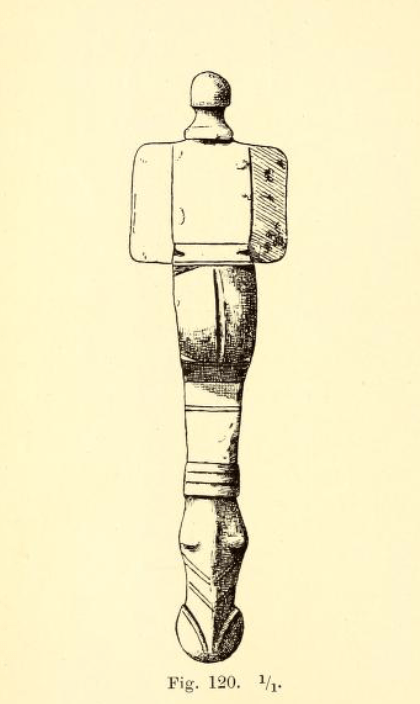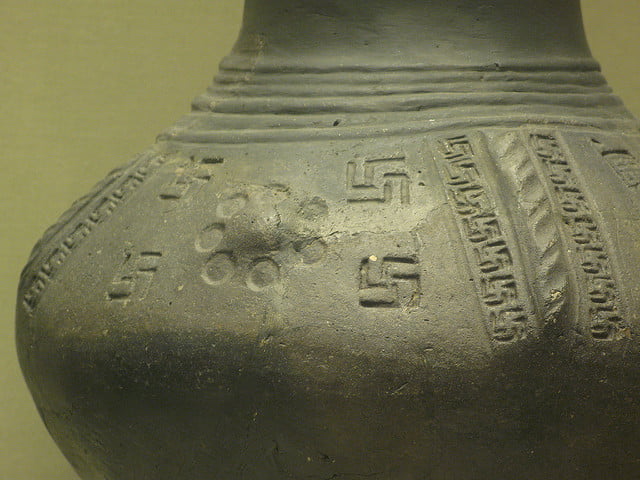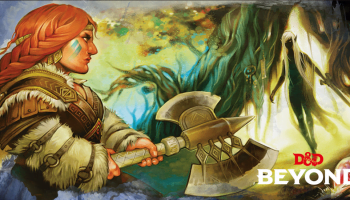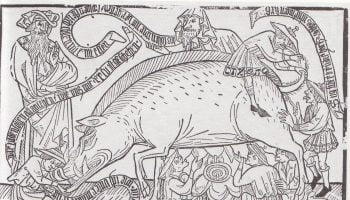This is Part III of The Public Medievalist’s continuing series on Race, Racism and the Middle Ages, written by James M. Harland.
Read the Introduction to the our series here, Part I, here, and Part II here.
Andrew Elliot’s previous article in this series touched upon how crucially important it is to properly and rigorously interpret evidence from the past. He showed what can happen when this goes horribly wrong, outlining some of the disturbing ideological projects which historical evidence has been misused to bolster.
There are few of us in medieval studies more keenly aware of these potential uses than those who work on early medieval archaeology. The reason for this is simple: our field, in its earlier iterations, was misused to help ideologically bolster Nazism.
Until the mid-twentieth century, the main interpretive framework through which archaeological evidence was interpreted was that of “Culture History.” This school of thought held that the patterns of distribution of objects found by archaeologists reflected the presence of already known ethnic groups. These groups were normally assumed to be closely bound through shared blood, language, location in space and time, appearance and culture.
The paradigm was established by scholars such as Professor of Archaeology at the University of Berlin, Gustaf Kossinna (1858-1931). Kossinna used a combination of linguistics and the distribution of prehistoric artefacts to argue that migrating Germans had been the founders of Indo-European civilization. Later, according to Kossinna, through their conquest of the Western Roman Empire, those Germans laid the foundations of many modern European nations. It is clear that his work is steeped in nationalism. But the influence of his ideas was not restricted to the far-right. For example, Gordon Childe was largely responsible for the paradigm’s dissemination in British archaeological scholarship, shorn of the more extreme views on race. Childe was a radical leftwinger. But the arguments of Culture History were especially compatible with Nazi ideology, since the Nazis were obsessed with establishing and maintaining what they claimed was the deep antiquity and purity of the German people. The SS even had a dedicated unit known as the Ahnenerbe—an archaeological strike force, if you like, who were sent to Poland, the Ukraine and Russia in the wake of the Blitzkrieg to capture items from ‘Germanic antiquity’ that could be used to justify the German Wehrmacht‘s advance.
The school of thought needn’t necessarily produce Nazis, of course—even Indiana Jones, famed for his Nazi-punching predilections, would have interpreted material culture through exactly the same frameworks. Many real early twentieth-century archaeologists were equally horrified by the appalling uses the Nazis made of their discipline. But the potential for abuse was there.
The “Culture History” framework has long since been rejected by archaeologists of all political stripes. It was based on extremely restricted sampling of materials, and made enormous and tenuous interpretive leaps on the most fragmentary, sometimes non-existent, traces of evidence.
Deconstructing Anglo-Saxon “Ethnicity”
In my research, I explore how archaeologists since the 1980s have approached the study of ethnic identity in the material record. I focus on Britain from the late fourth to the mid-sixth centuries, during what people call the “adventus saxonum”—the migration of the Anglo-Saxons to Britain after effective collapse of Roman rule. Before the 1980s, Anglo-Saxon archaeology was generally culture historical. Archaeologists produced immensely detailed catalogues and distribution maps of the different object types across England. These were used to identify and outline the specific distributions of the Anglian, Jutish and Saxon ethnic groups, following the guiding frameworks laid down by the eighth-century Northumbrian monk, Bede.
But during the 1970s and 80s, archaeologists began to think a bit more subtly about all this. Since the 1950s, anthropologists had increasingly recognized that concepts like ‘tribe’ and ‘race’ never quite work when mapped onto reality. Continued attachment to concepts like ‘tribe’ and ‘race’ was revealed to be grounded in attitudes originating from nineteenth- and twentieth-century European imperialism.
Anthropologists increasingly came to understand that what we now call ‘race’ and ‘ethnicity’ is what is called a “situational construct.” A situational construct is perhaps a paradox—it’s something that is imagined, but not imaginary. It is self-evident that ethnicity exists in the world, and has very real social power (as any minority at the receiving end of violence will tell you). But its characteristics are derived entirely from peoples’ beliefs about what it is. Its power is entirely in their social responses to it, and the social reproduction of these responses. Detailed empirical research decisively demonstrates that ethnicity cannot be simplistically tied to such characteristics as one’s blood, language, territory or genes. It can be remarkably fluid, and multilayered. Peoples’ ethnicity has even been known to be changeable, though such processes are, of course, far from straightforward.
This important idea ultimately brought a crisis in archaeology. In short, did the ‘culturally’ Anglo-Saxon artefacts that we found necessarily have to be used by Anglo-Saxons at all? Some scholars, like Cambridge archaeologist Sam Lucy, demonstrated that it is impossible to remove this research from nineteenth-century racist contexts. Lucy thus rejected the notion that ethnic identity was a useful category for studying the early Anglo-Saxon period at all. Examining cemeteries in East Yorkshire, the distribution patterns and uses of material that Lucy found didn’t seem to suggest (in East Yorkshire, at least) that medieval people drew clear boundaries between ethnic groups. Therefore, she argued, ethnic identity probably wasn’t an important category for these people. The only things truly observable were the expression of ‘local identities’, grounded in characteristics such as gender or age.
Pulling the Rug Out
Yet even this, in my view, has some problems. Like all accepted scientific paradigms, ethnic constructivism isn’t always approached critically. The only consistent criteria that scholars have found as the basis of ethnicity is a belief by an ethnic group’s members that they are members of the ethnic group in question. You are part of an ethnic group simply if you believe you are, and others agree (though the latter part is crucial. The case of Rachel Dolezal shows that one cannot simply choose their ethnicity, shorn of all connections to the structural and institutional power imbalances other members of that ethnicity have suffered) .
This has some serious implications. It sometimes means that we—both archaeologists and people in general—identify phenomena that resemble ethnic boundaries, and assume that’s what we’re witnessing. But without demonstrating this to be the case, we’re always on shaky ground. Sociologist Rogers Brubaker uses the horrors in former Yugoslavia in the 90s as an example; newscasters, policymakers, political figures and others with influence would, when attempting to explain the causes of the conflict, continually describe it as an ‘ethnic’ conflict between Bosnians, Serbs, and Croats. In reality, Brubaker shows, the people involved in the conflict who explicitly pursued ethnically-defined end goals, such as the main nationalist political parties, were a relatively small group. The underlying causes of the conflict were in reality far more complex, and people fought for a whole variety of conscious and unconscious reasons. But when external observers take people at their word that they are fighting for ethnic reasons, they ‘reify’ (make real) those groups. They reinforce that social phenomenon of ethnicity and ethnic strife by furthering belief in it. But, in doing so, they are imposing this simplistic explanation on complex events and phenomena without basis.
We simply lack any empirical means of demonstrating how the people burying these grave goods thought about themselves in terms of ethnicity. Anglo-Saxon objects are not definitively an expression of ethnic identity. Neither can we argue that they definitively weren’t. We simply don’t have any means of bridging the gap between the source material and the intentions, conscious or unconscious, of the people that made it. We don’t know how they identified themselves, and we simply can’t from this evidence.
What Are We Left With?
What might we be able to learn from these objects instead? My research focus on objects found in graves—remnants of clothing, weaponry, knives, regionally distinct brooches and belt buckles, beads, toiletry items, and combs—first seen in the fifth century. Leaving questions of ethnic identity aside, what traces of symbolic meaning can be identified? Many of the metalwork accessories come from Scandinavia and northern Germany; some of them display decoration which has origins in styles found on metalwork from the Roman military frontier.
Though these styles developed in, and came to Britain from, Scandinavia, they descend from sometimes only slightly earlier styles of Roman metalwork which also make an appearance in the region. These might have come to Scandinavia with barbarians who had served in the Roman Army, and whose families wished to display the status that this gave them when they were buried.
The Western Roman Empire was undergoing dramatic internal political and cultural changes in the fourth and fifth centuries. Most people know this as the ‘Fall of the Roman Empire’, but scholars today question the degree to which Rome truly ‘fell’, or simply transformed into a complex series of local governments with power shifting away from the center—which is not to say, of course, that the process wasn’t violent or unpleasant. Much of the research done in the last couple of decades has argued that these changes, which were previously assumed to have come from mass invasion, or ‘infiltration’ by a barbarian ‘fifth column’, were in reality a gradual militarization of the pre-existing Roman provincial elites. What we know about these so-called ‘barbarian’ groups was written entirely by Romans, and thus is rife with Roman prejudices.
Fashionable “Barbarians”
Like all imperial powers, the Roman Empire relied on stereotypes, misconceptions, and exaggerated traits in its depictions of the ‘non-civilised’ peoples it interacted with. There’s reason to believe that what we call the ‘barbarization’ of the Roman army—where Roman soldiers were supposedly infiltrated by barbarians—was instead conscious adoption by Romans of supposedly ‘barbarian’ traits. They did this partly because these gave the army an image of martial ferocity, not entirely unlike using ‘redskins’ as the name of an American football team—particularly because of the pejorative implications that that name carries.
In the early fifth century, elites on the continent begin to use the types of burial costume that are normally associated with barbarian migrants. But scholars such as Bonnie Effros, Guy Halsall, Edward James, Philipp von Rummel, and many others have shown that these costumes appeared in the Empire and in the barbarian homelands simultaneously. In some cases, they appeared in the Empire first! So it is absurd to attribute this to barbarian migration. A possible alternative these scholars put forward is that civilian displays of status ceased to be useful to provincial elites after the state’s infrastructure collapsed, and that these elites turned to more martial ways of showing their status.
British Barbarians?

In Britain, this becomes complicated. Unlike the continent, much of the British material clearly does migrate from Scandinavia and Germany. But we know that Saxons were first settled in Britain by the British authorities at some point in the late fourth or early fifth century, to serve as military reinforcements against Pictish and Irish raiders. Britain had become cut off from the Empire in the early fifth century, after rebelling twice—once in 383 and once in 407—with the goal of placing its own men on the imperial throne.
Pop histories and school textbooks will claim that the Empire ‘withdrew’ its armies to defend other parts of its territory. But it is far more likely that the Empire simply never managed to reassert control after the second rebellion. As a result, Britain suffered a massive social and economic collapse—though they at least didn’t vote for it in a referendum, that time. It may be, then, that the ‘Germanic’ metalwork we find in the early fifth-century burials might have been used as a substitute for the official Roman metalwork that expressed authority in the Empire. It appears at precisely the same time we see elites all across the Empire become concerned with military expressions of authority. Archaeologists sometimes go to great and elaborate lengths to explain why a burial contains both an early fifth-century ‘Romano-British’ belt buckle and a late fifth-century ‘Germanic’ brooch. The people doing the burying wouldn’t have seen this as a contradiction. Yes, the ‘Germanic’ brooch might have had its stylistic origins across the North Sea, but it still drew upon a stylistic grammar associated with Roman authority, just like the belt buckle.
Thus, the assumptions underpinning a ‘Pan-Germanic’ ideology are difficult to prove.
There is next to no evidence that the peoples of the Baltic, North Sea and Scandinavia self-consciously identified with one another in this period. That was an assumption concocted by linguistics that is often rejected today.
You’re Doing it Wrong.
Archaeology now approaches these questions completely differently, but popular depictions haven’t kept up. On Monday, The Times published an article about a recent archaeological study of Winchester. As the paper put it, ‘nine Romano-British or early Anglo-Saxon sites’ were studied, which allegedly contained ‘Germanic warriors’. Whether The Times mean a cultural or a racial category is never clear.
Andrew Welton–a PhD researcher at the University of Florida–pointed out that same day that The Times committed serious errors in archaeological reporting. The article casually blends studies of ancient skeletal height with studies of modern DNA and material culture, treating them as part of the same evidence package. Much of this can be put down to poor reporting, and the actual study is probably far more subtle. But The Times’ assertions were still derived from the authors’ own reports. The article suggests that the study makes a link between Anglo-Saxon ethnicity and increased skeletal height–due to the Saxons’ alleged superior diet! This claim is clearly based on more subtle modern work in the field that is still popular. But the article doesn’t mention that this argument is also heavily contested and has problems.
Two weeks ago, Theresa May was the first leader of a foreign nation to visit Donald Trump and welcome his presidency. In a joint press conference, May claimed that the United Kingdom and the United States share ‘a relationship based on the bonds of history, of family, kinship’.

For many of America’s founding fathers, this bond of kinship came from the white, Anglo-Saxon past. Thomas Jefferson proposed that the Great Seal of the United States feature Hengist and Horsa, ‘the Saxon chiefs from whom we claim the honor of being descended, and whose political principles and form of government we have assumed.’ Historians now widely believe Hengist and Horsa to be mythical. But so-called ‘Anglo-Saxon nationalists’ remain obsessed with these ideas. Their culture historical understanding of ‘Anglo-Saxon’ ethnicity is cross-fertilized by links to the Alt-Right, White Supremacists, and neo-Nazi groups.
It is a dangerous time to be peddling oversimplifications of the Anglo-Saxon past. Loose fragments of evidence and vague symbols are far too frequently used to weave elaborate and totally unprovable narratives. Some early Anglo-Saxon cremation urns, for example, feature stamped decorations including swastikas. That symbol’s presence on such artefacts in late Roman Scandinavia as well as northern Germany and ancient India was used to argue that the symbol must have been the preserve of ancient Aryans.
Such a claim is manifestly ridiculous. Some have claimed the swastika might represent the god Thor, but there is next to no evidence for this. Yet culture historical assumptions about a geometrically simple symbol were enough for Hitler to personally adopt it as the symbol of the most brutal and horrifying regime of the twentieth century.
The alternative I’ve offered above is debatable. The events of the fifth century are fraught with uncertainty. But we cannot treat highly debatable interpretations like facts. When we do that, we create space for very simplistic narratives. Such narratives can have genocidal consequences.
Continue to Part IV of our Series: Is Race Real?
The Public Medievalist does not pay to promote these articles, so we would love it if you shared this with your history-loving friends! Click to share with your friends on Facebook, or Twitter.





Public Medievalist, thank you so much for publishing this series. I find it fascinating, educational and timely.